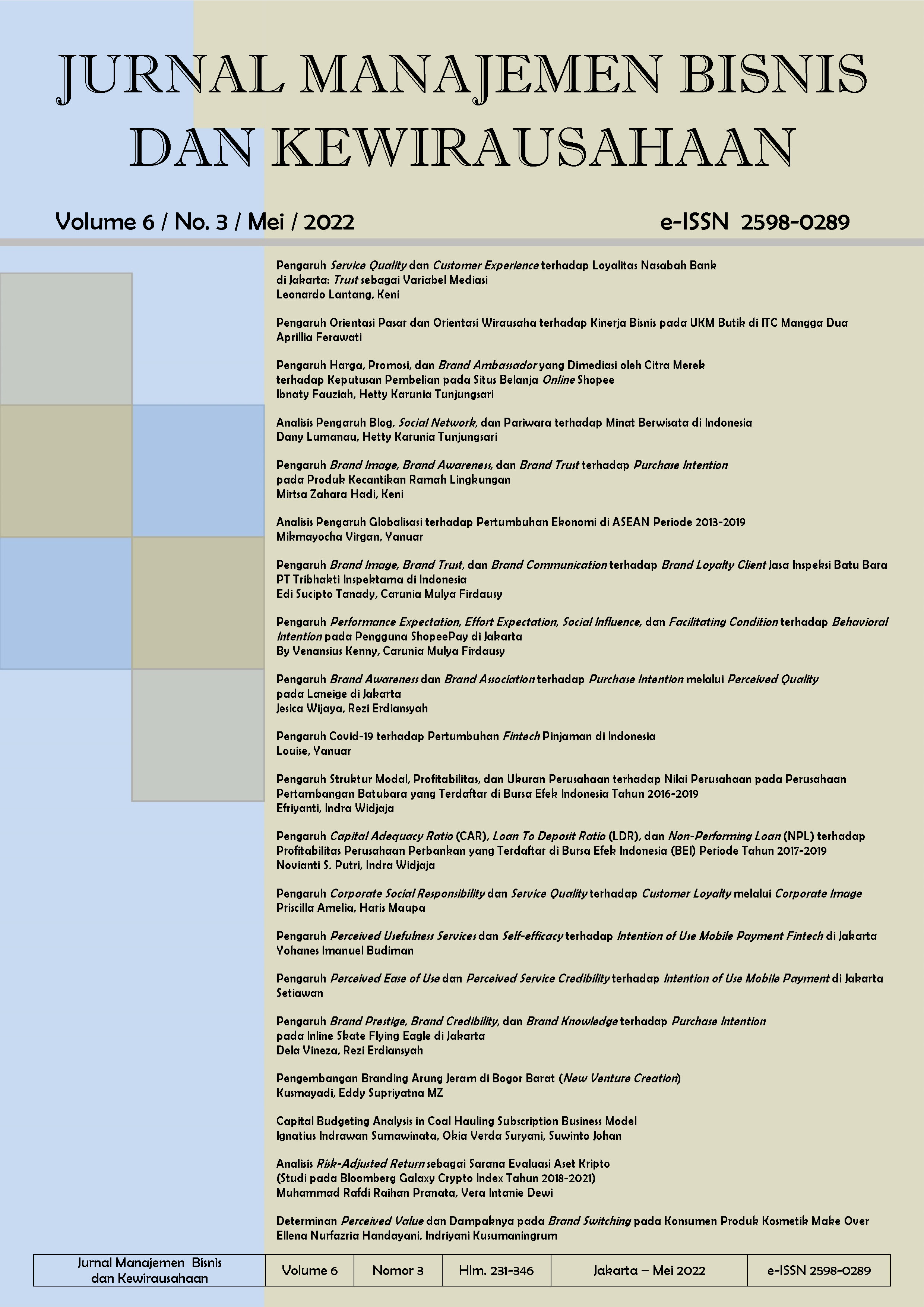Pengaruh Perceived Ease of Use dan Perceived Service Credibility terhadap Intention of Use Mobile Payment di Jakarta
Main Article Content
Abstract
The purpose of this research is to identify the effect of Perceived Ease of Use and Perceived Service Credibility on the Intention of Use mobile payment in Jakarta. The data in this research was collected through a questionnaire method using Google Form. The sample used as many as 324 respondents the owner of bank accounts and mobile payment application users who live in Jakarta. The research results showed that there is a positive and significant implication between Perceived Ease of Use and Perceived Service Credibility towards Intention of Use Mobile Payment in Jakarta.
Tujuan dari riset ini adalah untuk mengidentifikasi pengaruh antara Perceived Ease of Use dan Perceived Service Credibility terhadap Intention of Use mobile payment di Jakarta. Data dalam penelitian ini diambil dari metode kuesioner menggunakan Google Form. Sampel yang digunakan sebanyak 324 orang responden pemilik rekening bank dan pengguna aplikasi mobile payment yang tinggal di Jakarta. Penelitian ini menggunakan teknik analisis PLS (Partial Least Square). Hasil penelitian ini menunjukan adanya pengaruh positif dan signifikan antara Perceived Ease of Use dan Perceived Service Credibility terhadap Intention of Use mobile payment di Jakarta.
Article Details
This work is licensed under a Jurnal Manajemen Bisnis dan Kewirausahaan Creative Commons Attribution-ShareAlike 4.0 International License.
References
Ashghar, S. A., & Nurlatifah, H. (2020). Analisis pengaruh perceived ease of use, perceived usefulness, dan perceived risk terhadap keinginan membeli kembali melalui e-trust dan s-satisfaction (Studi kasus pengguna Gopay pada transaksi UMKM). Jurnal Al Azhar Indonesia Seri Ilmu Sosial, 1(1), 40. https://doi.org/10.36722/jaiss.v1i1.459
Asosiasi Penyelenggara Jasa Internet Indonesia (APJII). (2018). Survei APJII: Penetrasi internet di Indonesia capai 143 juta jiwa. Buletin APJII. https://apjii.or.id/downfile/file/BULETINAPJIIEDISI22Maret2018.pdf
Atkinson, A., & Messy, F.-A. (2012). Measuring financial literacy: Results of the OECD / international network on financial education (INFE) pilot study (No. 15; OECD Working Papers on Finance, Insurance and Private Pensions). https://doi.org/10.1787/5k9csfs90fr4-en
Bangkara, R. P., & Mimba, N. P. S. H. (2016). Pengaruh perceived usefulness dan perceived ease of use pada minat penggunaan internet banking dengan attitude toward using sebagai variabel intervening. E-Jurnal Akuntansi Universitas Udayana, 16(3), 2408–2434. https://ojs.unud.ac.id/index.php/Akuntansi/article/view/21551/15419
Cholifah, R. N. (2020). Pengaruh perceived usefulness, perceived ease of use dan trust terhadap intention to use [Skripsi, Universitas Islam Negeri Syarif Hidayatullah]. https://repository.uinjkt.ac.id/dspace/bitstream/123456789/50192/1/RIZKY NUR CHOLIFAH-FEB.pdf
Davis, F. D. (1989). Perceived usefulness, perceived ease of use, and user acceptance of information technology. MIS Quarterly: Management Information Systems, 13(3), 319–339. https://doi.org/10.2307/249008
Fadlilah, N. (2018). Pengaruh perceived usefulness dan perceived enjoyment terhadap kinerja karyawan BMT UGT Sidogiri [Skripsi, Universitas Islam Negeri Sunan Ampel Surabaya]. http://digilib.uinsby.ac.id/24255/1/Ni%27matul Fadlilah_G94214151.pdf
Gefen, D., Karahanna, E., & Straub, D. W. (2003). Inexperience and experience with online stores: The importance of TAM and trust. IEEE Transactions on Engineering Management, 50(3), 307–321. https://doi.org/10.1109/TEM.2003.817277
Hatmojo, H. B. D., Mursityo, Y. T., & Wardani, N. H. (2019). Evaluasi efikasi diri dan persepsi kredibilitas pengguna sistem informasi perencanaan dan penganggaran pada badan perencanaan, penelitian, pengembangan kota Malang dengan metode technology acceptance model (TAM) termodifikasi. Jurnal Pengembangan Teknologi Informasi dan Ilmu Komputer, 3(6), 5917–5925. https://j-ptiik.ub.ac.id/index.php/j-ptiik/article/view/5481/2578
Henseler, J., Ringle, C. M., & Sinkovics, R. R. (2009). The use of partial least squares path modeling in international marketing. In R. R. Sinkovics & P. N. Ghauri (Eds.), New Challenges to International Marketing (Advances in International Marketing) (Vol. 20, pp. 277–319). Emerald Group Publishing Limited. https://doi.org/10.1108/S1474-7979(2009)0000020014
Hogarth, J. M. (2002). Financial literacy and family and consumer sciences. Journal of Family and Consumer Sciences, 94(1), 14–28. https://www.proquest.com/scholarly-journals/financial-literary-family-consumer-scences/docview/218195497/se-2?accountid=45753
Johan, S. (2020). Users’ acceptance of financial technology in an emerging market (An empirical study in Indonesia). Jurnal Ekonomi dan Bisnis, 23(1), 173–188. https://doi.org/10.24914/jeb.v23i1.2813
Keimas, A. (2018). Sejauh apa industri fintech berkembang di Indonesia? (E. M. Rahayu (ed.)). SWA Online. https://swa.co.id/swa/trends/sejauh-apa-industri-fintech-berkembang-di-indonesia
Otoritas Jasa Keuangan. (2016). Survei nasional literasi dan inklusi keuangan 2016. https://sikapiuangmu.ojk.go.id/FrontEnd/images/Document/buku statistik_2016.pdf
Putri, R. A., & Afandy, C. (2020). Dampak dimensi individual financial literacy terhadap financial conclusion pada masyarakan pedesaan. Managament Insight: Jurnal Ilmiah Manajemen, 15(1), 33–48. https://doi.org/10.33369/insight.15.1.33-48
Remund, D. L. (2010). Financial literacy explicated: The case for a clearer definition in an increasingly complex economy. Journal of Consumer Affairs, 44(2), 276–295. https://doi.org/10.1111/j.1745-6606.2010.01169.x
Rooij, M. van, Lusardi, A., & Alessie, R. (2007). Financial literacy and stock market participation (No. 13565; NBER Working Paper). https://www.nber.org/system/files/working_papers/w13565/w13565.pdf
Trihutama, R. P. (2020). Pengaruh perceived ease of use, perceived usefulness, dan trust terhadap behavioral intention to use (Studi pada pengguna Go-Pay layanan Go-Jek). Jurnal Kajian Manajemen dan Wirausaha, 2(2), 1–15. https://jimfeb.ub.ac.id/index.php/jimfeb/article/view/4865/4269
Wang, Y., Wang, Y., Lin, H., & Tang, T. (2003). Determinants of user acceptance of Internet banking: an empirical study. International Journal of Service Industry Management, 14(5), 501–519. https://doi.org/10.1108/09564230310500192
Wibowo, S. F., Rosmauli, D., & Suhud, U. (2015). Pengaruh persepsi manfaat, persepsi kemudahan, fitur layanan, dan kepercayaan terhadap minat menggunakan e-money card (Studi pada pengguna jasa commuterline di Jakarta). JRMSI - Jurnal Riset Manajemen Sains Indonesia, 6(1), 440–456. https://doi.org/10.21009/jrmsi.006.1.06


